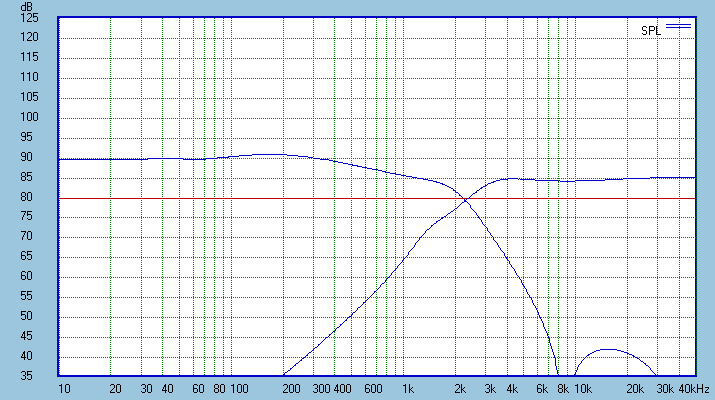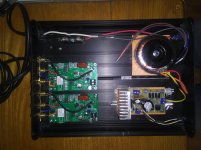I just stumbled across this crossover kit. It looks works off a single DC supply (if I have read the product manual correctly) and can be ordered with parts for different frequencies. It is listed under their 'new products for August' in their audio kits section which may explain why I had not seen it before.
Anyone have any experience with building one of these? They are only mono and I was thinking of using one for an active-crossover center speaker perhaps.
Anyone have any experience with building one of these? They are only mono and I was thinking of using one for an active-crossover center speaker perhaps.
Hi,
Generally a very bad idea as they do not provide the typical transfer
functions required for a properly designed crossover, active or passive.
See the centre design here : Zaph|Audio - ZA5 Speaker Designs with ZA14W08 woofer and Vifa DQ25SC16-04 tweeter

It could work if you knew how to add the baffle step compensation
seen in the above to the active filter, but if you don't .............
(The transfer function also includes a notch filter typically used
on metal cone drivers too, but high slopes can avoid this.)
rgds, sreten.
Generally a very bad idea as they do not provide the typical transfer
functions required for a properly designed crossover, active or passive.
See the centre design here : Zaph|Audio - ZA5 Speaker Designs with ZA14W08 woofer and Vifa DQ25SC16-04 tweeter

It could work if you knew how to add the baffle step compensation
seen in the above to the active filter, but if you don't .............
(The transfer function also includes a notch filter typically used
on metal cone drivers too, but high slopes can avoid this.)
rgds, sreten.
Last edited:
I take your point and would not build an MTM center again due to the off axis interference patterns. However, the PAF means I still need a horizontal speaker (plus design constraints are the mother of innovation).
I am thinking WMTW with a steep active crossover in the 300-400hz region using three 5-5.5" drivers.
As a current center speaker design I am building (WTM three way) has shown me, good passive crossover performance at 300ish hz is troublesome. The impedance peaks are significant and the components (solen air core inductors) are massive when laid out and expensive. This is at 12dB per octave.
All I am really trying to do here is get all the bass frequencies off the speaker that has to produce super articulate mids for dialogue. Getting the bass off the relevant amplifier would be a bonus. Furthermore, my (small) experience with relatively high order active crossovers so far is that it makes for such a small area of overlap at the crossover point that other design constraints can be relaxed a little if need be. Building 4th order passive crossovers that are impervious to driver impedance is something I will not be attempting
Also FWIW baffle step is easy enough to tweak in an active system.
I am thinking WMTW with a steep active crossover in the 300-400hz region using three 5-5.5" drivers.
As a current center speaker design I am building (WTM three way) has shown me, good passive crossover performance at 300ish hz is troublesome. The impedance peaks are significant and the components (solen air core inductors) are massive when laid out and expensive. This is at 12dB per octave.
All I am really trying to do here is get all the bass frequencies off the speaker that has to produce super articulate mids for dialogue. Getting the bass off the relevant amplifier would be a bonus. Furthermore, my (small) experience with relatively high order active crossovers so far is that it makes for such a small area of overlap at the crossover point that other design constraints can be relaxed a little if need be. Building 4th order passive crossovers that are impervious to driver impedance is something I will not be attempting

Also FWIW baffle step is easy enough to tweak in an active system.
Hi,
Of course it is. So are lots of things you can build into active circuitry
to properly hit your acoustic design goals, some not as simple as
generic "BSC".
That line level BSC circuit is a poor solution for an active x/o.
Proper active x/o's don't come "off the shelf", they are purpose designed
for the particular drivers and application, just like proper passive design.
rgds, sreten.
Proper active x/o's don't come "off the shelf", they are purpose designed
for the particular drivers and application, just like proper passive design.
While the very best results could be obtained by designing an active crossover to match a driver I think saying that active crossovers need to be purpose built just like passive ones overstates things.
If a driver has a nice linear frequency response over a particular range and an active crossover is applied 'off the shelf' the results are fairly predictable. For passive crossovers the variations in driver impedance would mean this is not true.
You would be better off getting a L-R crossover board from ESP, they don't say what type of filter they are using in that kit.
You do get a good result from a 4th. order L-R active filter over quite a wide range of driver characteristics, this was shown by Bullock in an AES paper, and typically acoustic center offset will have more influence than the interactions of the filter and driver transfer functions.
rcw
You do get a good result from a 4th. order L-R active filter over quite a wide range of driver characteristics, this was shown by Bullock in an AES paper, and typically acoustic center offset will have more influence than the interactions of the filter and driver transfer functions.
rcw
This is a matlab simulation of a typical system...
This is a lf driver with a q=2 upper roll off an octave above the crossover frequency, a tweeter with a Butterworth roll off an octave bellow it, when you sum them you get this...
It is not perfect but is good enough, and in practice the acoustic offset has far more effect.
Edit: I forgot to mention that in the second plot the drivers have been convolved with 4th. order L-R isolated filters and the results summed.
rcw.
An externally hosted image should be here but it was not working when we last tested it.
This is a lf driver with a q=2 upper roll off an octave above the crossover frequency, a tweeter with a Butterworth roll off an octave bellow it, when you sum them you get this...
An externally hosted image should be here but it was not working when we last tested it.
It is not perfect but is good enough, and in practice the acoustic offset has far more effect.
Edit: I forgot to mention that in the second plot the drivers have been convolved with 4th. order L-R isolated filters and the results summed.
rcw.
Last edited:
Thanks RCW. I was a bit troubled about the absence of information on what kind of filter they were using too.
I have built one of Rod's 2way 4th order LR crossovers. I set it at 2k and built a ported two way with HiVi D8G and a Scanspeak D2604/830000. The woofer is an oversize 8" and the tweeter diaphragm is 32mm. The results are astoundingly good.
Though it all worked first time, my profession involves office work and just getting all the parts in one place etc. was a major undertaking. The idea of a mono two way kit that operates off a single power supply is attractive.
I could not follow the links to Rod's forums. My email asking for access (a while ago now) must have gotten overlooked. I will include a fresh request with an upcoming order (guitar amp and another crossover for some floor standing three ways) and come back to your post.
FWIW I am in the midst of a minidsp/mindigi 2.1 project for some far out PC speakers. However, I will be putting the DSP in a box with a 4 channel class D amp that will let me prototype stuff. Am looking forward to auditioning 8th order filters and fiddling with time alignment for example. However, I suspect that gains over Rod's crossover will be small at most.
I have built one of Rod's 2way 4th order LR crossovers. I set it at 2k and built a ported two way with HiVi D8G and a Scanspeak D2604/830000. The woofer is an oversize 8" and the tweeter diaphragm is 32mm. The results are astoundingly good.
Though it all worked first time, my profession involves office work and just getting all the parts in one place etc. was a major undertaking. The idea of a mono two way kit that operates off a single power supply is attractive.
I could not follow the links to Rod's forums. My email asking for access (a while ago now) must have gotten overlooked. I will include a fresh request with an upcoming order (guitar amp and another crossover for some floor standing three ways) and come back to your post.
FWIW I am in the midst of a minidsp/mindigi 2.1 project for some far out PC speakers. However, I will be putting the DSP in a box with a 4 channel class D amp that will let me prototype stuff. Am looking forward to auditioning 8th order filters and fiddling with time alignment for example. However, I suspect that gains over Rod's crossover will be small at most.
Last edited:
- Home
- Source & Line
- Analog Line Level
- Xkitz 2-way Active Crossover Kit
